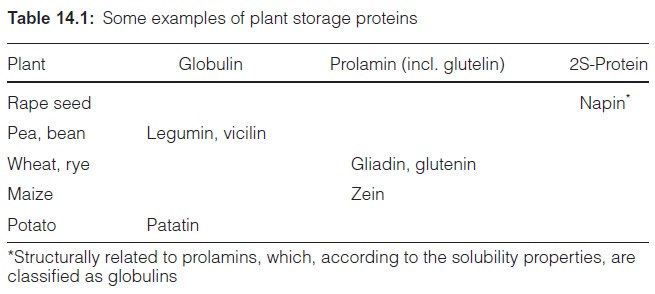Chapter: Plant Biochemistry: Products of nitrate assimilation are deposited in plants as storage proteins
Products of nitrate assimilation are deposited in plants as storage proteins
Products of nitrate assimilation are deposited in plants as storage proteins
Whereas the products of CO2 assimilation are deposited in plants in the form of oligo- and polysaccharides, the amino acids formed as products of nitrate assimilation are stored as proteins. These are mostly special storage proteins, which have no enzymatic activity and are often deposited in the cell within protein bodies. Protein bodies are enclosed by a single membrane that derived from the endomembrane sys-tem of the endoplasmic reticulum and the Golgi apparatus or the vacuoles. In potato tubers, storage proteins are also stored in the vacuole.
Storage proteins can be deposited in various plant organs, such as leaves, stems, and roots. They are stored in seeds and tubers and also in the cambium of tree trunks during winter to enable the rapid formation of leaves during seed germination and sprouting. Storage proteins are located in the endosperm in cereal seeds and in the cotyledons of most legume seeds. Whereas in cereals the protein content amounts to 10% to 15% of the dry weight, in some legumes (e.g., soybean) it is as high as 40% to 50%. About 85% of these proteins are storage proteins.
Globally, about 70% of the human demand for protein is met by the consumption of seeds, either directly or indirectly by feeding them to ani-mals for meat production. Therefore plant storage proteins are the impor-tant basis for human nutrition. However, in many plant storage proteins the content of nutritionally essential amino acids is too low. In cereals, for example, the storage proteins are limited in threonine, tryptophan, and particularly in lysine, whereas in legumes there is a shortage of methionine. Since these amino acids cannot be synthesized by the human metabo-lism, humans have to take up essential amino acids through their food. In humans with an entirely vegetarian diet, the deficiency of essential amino acids can lead to irreparable physical and mental damage, especially in chil-dren. It can also be a serious problem in pig and poultry fodder. A research goal in plant genetic engineering is to improve the amino acid composition of the storage proteins of harvest products.

Scientists have long been interested in plant proteins. In 1745 the Italian Jacopo Beccari isolated proteins from wheat. In 1924, Thomas Osborne, at the Connecticut Agricultural Experimental Station, classified plant pro-teins according to their solubility properties. He fractionated plant proteins into albumins (soluble in pure water), globulins (soluble in diluted salt solutions), glutelins(soluble in diluted solutions of alkali and acids), and prolamins (soluble in aqueous ethanol). Later, when the structures of theseproteins were determined, it turned out that glutelins and prolamins were structurally closely related. Therefore, in more recent literature, glutelins are regarded as members of the group of prolamins. Table 14.1 shows some examples of various plant storage proteins.
Related Topics